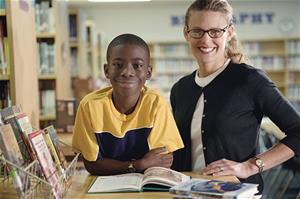
Within tiered intervention frameworks, collaboration is an essential key to providing early and effective intervention for students who may lag behind their peers. Stalled and unresponsive to our coaching, it may be time to expand collaboration and invite coaches with unique skill sets and fresh perspectives to join our intervention teams. Our students need these skills to get in the game, yet they’re stuck sitting on the dugout and warming the bench.
Who’s missing from intervention teams?
After reading numerous research articles on tiered intervention, a common theme emerged: Occupational and physical therapists are left out of the discussion. Yet, as a reading coach, I have come to value these roles in my own lineup.
For students in reading intervention programs, therapists have a lot to offer in terms of strategies to get students off the bench and into the game. Therapists contribute unique skill sets when it comes to helping children access reading curricula—especially students with autism, ADHD, sensory processing issues, dyslexia, and writing challenges.
Expanded definition of stamina
The term “reading stamina” is often used when describing a student’s ability to focus and read independently without being distracted or distracting others. From a therapist’s perspective, stamina includes not only the ability to focus for literacy lessons, but also the ability to monitor his or her own behavior and to know what to do when focus starts to wander.
Additionally, the therapist’s view of stamina includes the ability to sit upright at a desk; to understand directional tracking, or to process letters in order from left to right; and to “cross midline,” or to use and move the limbs of one side of the body in the space of the opposite side (for example, holding a paper with one hand while writing with the other).
When students struggle to build reading stamina, they may warm the bench longer than students who do not. Getting students off the bench and into the game is easier when using therapy strategies proven effective for improving literacy skills for the diverse readers in today’s classrooms.
“In the school environment, our jobs are to provide access to school curricula for all students. Going into the classrooms to support students and teachers is rewarding,” says Rachel Gambino, a physical therapist in Long Island, NY. “We help our students to be more available for learning and feel successful alongside their peers.”
Collaborating with therapists taught me that a few simple yet effective techniques can go a long way toward turning passive benchwarmers into active players. Three valuable concepts I learned from working with therapists are deep pressure, heavy work, and self-regulation.
Deep pressure
As mindfulness and meditation becoming buzzwords in today’s classrooms, it’s important to understand that, when deep pressure is added to deep breathing, the routine becomes even more effective—especially for children with ADHD and sensory processing issues.
A simple deep pressure technique is to press into the palm of one hand with the thumb of the other. Press all around the palm on one hand to a count of 10. Stop. Take a deep breath and repeat on the other hand. Stop. Take another deep breath.
Then squeeze 10 times up one arm. Stop. Take a deep breath and squeeze up the other arm. This simple technique activates the vagus nerve and causes the release of serotonin in our bodies, which reduces stress and increases feelings of safety. This is essential for students who become stressed during reading activities, such as timed tests.
For added benefit, children can spell words during deep pressure therapy. This simple activity helps with both word retention and overall focus.
Heavy work and spelling
While collaborating with classroom teachers, occupational therapist Jennifer Vogtmann introduced heavy work—a therapy technique that uses large muscle movement to help children calm down and focus.
She says students’ favorite activity is to do wall push-ups while reading their sight words, which are posted on the wall above. This activity improves postural stability, shoulder differentiation for writing, and visual convergence for reading—all while building that all-important reading stamina.
According to Heidi Bartle, principal at Michigamme Elementary School, MI, this exercise has been effective.
“We have seen tremendous gains in our students' overall academic performance, especially in math and spelling scores, due to the wall push-ups,” she says.
Self-regulation
Therapists have shown me the value of teaching children how to monitor their own behavior and to recognize when they are losing focus or need to move. I’ve learned that there is no point in pushing students through literacy lessons when they are unduly stressed, tired, antsy, or losing focus.
Next time you gather your intervention team, invite the therapists to the coaching strategy meeting. In doing so, there’s a good chance your benchwarmers will be swinging for the fences in no time.
Debra Em Wilson is a reading specialist and collaboration coach and the founder of S’cool Moves.